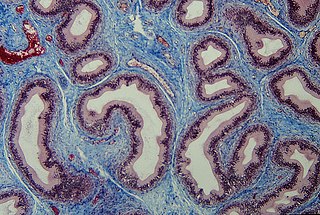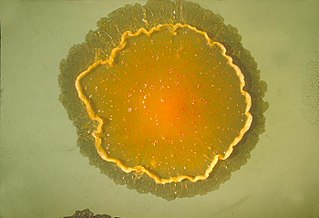
Pathology is the study of disease and injury. The word pathology also refers to the study of disease in general, incorporating a wide range of biology research fields and medical practices. However, when used in the context of modern medical treatment, the term is often used in a narrower fashion to refer to processes and tests that fall within the contemporary medical field of "general pathology", an area that includes a number of distinct but inter-related medical specialties that diagnose disease, mostly through analysis of tissue and human cell samples. Idiomatically, "a pathology" may also refer to the predicted or actual progression of particular diseases. The suffix pathy is sometimes used to indicate a state of disease in cases of both physical ailment and psychological conditions. A physician practicing pathology is called a pathologist.

Connective tissue is one of the four primary types of animal tissue, along with epithelial tissue, muscle tissue, and nervous tissue. It develops mostly from the mesenchyme, derived from the mesoderm, the middle embryonic germ layer. Connective tissue is found in between other tissues everywhere in the body, including the nervous system. The three meninges, membranes that envelop the brain and spinal cord, are composed of connective tissue. Most types of connective tissue consists of three main components: elastic and collagen fibers, ground substance, and cells. Blood, and lymph are classed as specialized fluid connective tissues that do not contain fiber. All are immersed in the body water. The cells of connective tissue include fibroblasts, adipocytes, macrophages, mast cells and leukocytes.
The National Institute of Arthritis and Musculoskeletal and Skin Diseases (NIAMS) is one of the institutes and centers that make up the National Institutes of Health, an agency of the United States Department of Health and Human Services (HHS).
Pathophysiology is a branch of study, at the intersection of pathology and physiology, concerning disordered physiological processes that cause, result from, or are otherwise associated with a disease or injury. Pathology is the medical discipline that describes conditions typically observed during a disease state, whereas physiology is the biological discipline that describes processes or mechanisms operating within an organism. Pathology describes the abnormal or undesired condition, whereas pathophysiology seeks to explain the functional changes that are occurring within an individual due to a disease or pathologic state.

Ichthyosis vulgaris is a skin disorder causing dry, scaly skin. It is the most common form, and one of the mildest forms, of ichthyosis, affecting around 1 in 250 people. For this reason it is known as common ichthyosis. It is usually an autosomal dominant inherited disease, although a rare non-heritable version called acquired ichthyosis exists.

Harrison's Principles of Internal Medicine is an American textbook of internal medicine. First published in 1950, it is in its 21st edition and comes in two volumes. Although it is aimed at all members of the medical profession, it is mainly used by internists and junior doctors in this field, as well as medical students. It is widely regarded as one of the most authoritative books on internal medicine and has been described as the "most recognized book in all of medicine."

Hyperpigmentation is the darkening of an area of skin or nails caused by increased melanin.

Hyperplasia, or hypergenesis, is an enlargement of an organ or tissue caused by an increase in the amount of organic tissue that results from cell proliferation. It may lead to the gross enlargement of an organ, and the term is sometimes confused with benign neoplasia or benign tumor.

Intertrigo, commonly called “skin fold dermatitis”, refers to a type of inflammatory rash (dermatitis) of the superficial skin that occurs within a person's body folds. These areas are more susceptible to irritation and subsequent infection due to factors that promote skin breakdown such as moisture, friction, and exposure to bodily secretions and excreta such as sweat, urine, or feces. Areas of the body which are more likely to be affected by intertrigo include the inframammary fold, intergluteal cleft, armpits, and spaces between the fingers or toes. Skin affected by intertrigo is more prone to infection than intact skin.

Staphylococcal scalded skin syndrome (SSSS) is a dermatological condition caused by Staphylococcus aureus.

Erythrasma is a superficial skin infection that causes brown, scaly skin patches. It is caused by Corynebacterium minutissimum bacteria, a normal part of skin flora.

Acrodermatitis enteropathica is an autosomal recessive metabolic disorder affecting the uptake of zinc through the inner lining of the bowel, the mucous membrane. It is characterized by inflammation of the skin (dermatitis) around bodily openings (periorificial) and the tips of fingers and toes (acral), hair loss (alopecia), and diarrhea. It can also be related to deficiency of zinc due to other, i.e. congenital causes.

Mycobacterium marinum is a slow growing fresh and saltwater mycobacterium (SGM) belonging to the genus Mycobacterium and the phylum Actinobacteria. It was formerly known as Mycobacterium balnei. The strain marinum was first identified by Joseph D. Aronson in 1926 and it is observed as a pathogenic mycobacterium causing tuberculosis-like infections in fish (mycobacteriosis) and skin lesions in humans. The bacteria grows optimal at a temperature around 30 °C.

Dequalinium is a quaternary ammonium cation and bolaamphiphile commonly available as the dichloride salt. It is useful as an antiseptic and disinfectant. The bromide, iodide, acetate, and undecenoate salts are known as well. Dequalinium chloride is the active ingredient of several medications.

Subcutaneous emphysema occurs when gas or air accumulates and seeps under the skin, where normally no gas should be present. Subcutaneous refers to the subcutaneous tissue, and emphysema refers to trapped air pockets. Since the air generally comes from the chest cavity, subcutaneous emphysema usually occurs around the upper torso, such as on the chest, neck, face, axillae and arms, where it is able to travel with little resistance along the loose connective tissue within the superficial fascia. Subcutaneous emphysema has a characteristic crackling-feel to the touch, a sensation that has been described as similar to touching warm Rice Krispies. This sensation of air under the skin is known as subcutaneous crepitation, a form of crepitus.

Parakeratosis is a mode of keratinization characterized by the retention of nuclei in the stratum corneum. In mucous membranes, parakeratosis is normal. In the skin, this process leads to the abnormal replacement of annular squames with nucleated cells. Parakeratosis is associated with the thinning or loss of the granular layer and is usually seen in diseases of increased cell turnover, whether inflammatory or neoplastic. Parakeratosis is seen in the plaques of psoriasis and in dandruff.
Alezzandrini syndrome is a very rare syndrome characterized by a unilateral degenerative retinitis, followed after several months by ipsilateral vitiligo on the face and ipsilateral poliosis. Deafness may also be present.

Candidal intertrigo is an infection of the skin by Candida albicans, more specifically located between intertriginous folds of adjacent skin.

The Journal of Molecular Medicine is a monthly, peer-reviewed, scientific journal published by Springer Science+Business Media. It covers all aspects of human biology and pathophysiology. The emphasis is on the progress and precision now possible in the understanding, prevention, diagnosis and treatment of human diseases. The employment of molecular biology and gene technology has enhanced the understanding of human diseases and has created a new branch of research known as "molecular medicine".

Biomedical sciences are a set of sciences applying portions of natural science or formal science, or both, to develop knowledge, interventions, or technology that are of use in healthcare or public health. Such disciplines as medical microbiology, clinical virology, clinical epidemiology, genetic epidemiology, and biomedical engineering are medical sciences. In explaining physiological mechanisms operating in pathological processes, however, pathophysiology can be regarded as basic science.
















